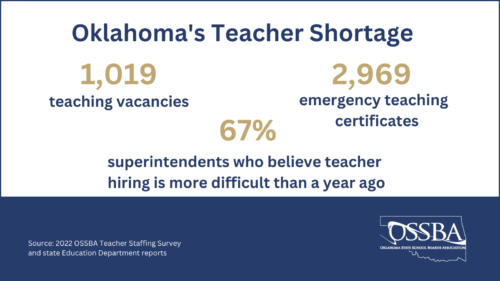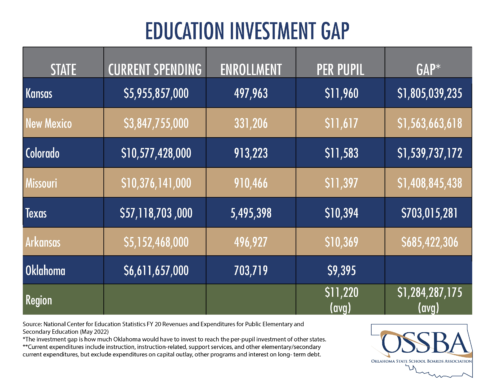Teacher Staffing Survey Shows Record Vacancies
Annual OSSBA Survey Tracks Teacher Shortage Challenge
A new survey shows the struggle to recruit and retain educators in Oklahoma is reaching new levels.
Oklahoma schools reported 1,019 teaching vacancies as the 2022-2023 school year began even as they are on pace to employ record numbers of emergency certified teachers and plan to expand the use of adjunct instructors, according to the Oklahoma State School Board Association’s annual teacher staffing survey.
 The vacancy number is the highest in the nine-year history of the survey. In 2016, districts reported 1,000 vacancies. It’s also a significant jump over last year, when districts reported 680 vacancies. The numbers match the sentiment of school administrators charged with staffing classrooms – nearly 70% said the teacher hiring market is worse than a year ago.
The vacancy number is the highest in the nine-year history of the survey. In 2016, districts reported 1,000 vacancies. It’s also a significant jump over last year, when districts reported 680 vacancies. The numbers match the sentiment of school administrators charged with staffing classrooms – nearly 70% said the teacher hiring market is worse than a year ago.
“Most of us have never lived in a time like this when schools – and the entire country – are still rebounding from pandemic disruptions,” OSSBA Executive Director Shawn Hime said. “This is the right time to make a bold, unprecedented commitment to ensuring every Oklahoma child is in a classroom with a high-quality teacher who has the training and resources they need to help every student succeed.”
Hime said education leaders along with parents, community and business leaders and legislators must commit to working together to ensure Oklahoma students remain the state’s top priority and collaborate on solutions for the teacher shortage crisis.
“Investing in education is the best form of economic development,” he said. “Our students deserve it. And it’s the best strategy to shore up the teacher pipeline by retaining the teachers who are in today’s classrooms while making teaching an attractive profession for high school, college students and those interested in changing careers to consider.”
Other findings from this year’s survey, which included responses from 328 districts representing 77% of the state’s student population during the first week of August:
• Very little has changed over the years in the most difficult-to-fill areas. Special education remains the most difficult area to fill followed by secondary math and science teachers.
• 25% of school districts increased teacher compensation compared to last year, either through salary increases, retention/recruitment stipends or both.
• 60% of school districts increased compensation for support professionals through pay raises, through a mix of pay raises and recruitment/retention stipends.
• In addition to pay, districts have offered the following incentives for employees: no- or low-cost daycare and before- and after-school programs; increased benefits; expanded the years of experience accepted (especially out-of-state) to determine a teacher’s salary scale placement; tuition reimbursement; biweekly paychecks; low-cost housing or house incentives; additional paid professional development opportunities; and classroom grants through private partnerships; and financial assistance for certification tests.
• 85% of districts anticipate a substitute teacher shortage.
• Districts hope to restore several hundred positions that were cut or went unfilled the last two years. Public schools had 500 fewer teachers in 2021-2022 than two years prior, according to state Education Department figures.
While districts receive no new funding through the state education budget for the current fiscal year, the survey found many are using federal pandemic relief funds to temporarily bolster recruitment and retention efforts.
Increased investment in education in four of the last five years resulted in increased teacher compensation for a time above the average of surrounding states. But other states continue to invest and the latest rankings show Oklahoma has fallen behind the regional average. Driving that change is a frustrating reality: Oklahoma remains last in the region in per-student investment in education and would need an infusion of $1.2 billion annually just to reach the average invested per student in surrounding states, according to the most recent federal data.
 “Education leaders are incredibly grateful for the work legislators have accomplished in recent years in an attempt to ease the shortage and strengthen the teacher pipeline,“ Hime said. “But the survey and other data paint a pretty clear picture: the work is far from done.”
“Education leaders are incredibly grateful for the work legislators have accomplished in recent years in an attempt to ease the shortage and strengthen the teacher pipeline,“ Hime said. “But the survey and other data paint a pretty clear picture: the work is far from done.”
Legislative changes in recent years allowing greater flexibility in hiring emergency certified teachers, bringing retirees back to the classroom and allowing adjunct instructors to teach more classes are filling gaps.
• Districts are on track to break last year’s record-high number of emergency certified teachers. Almost 3,000 emergency certificates have been approved so far this school year – about 300 ahead of the same time last year.
• Dozens of districts also report they’ll leverage changes in state law allowing adjunct instructors to teach more courses. Earlier this year, legislators approved and the governor signed Senate Bill 1119 by Sen. Jessica Garvin, R-Duncan, and Rep. Kyle Hilbert, R-Bristow, which eliminated a cap on how many hours an adjunct instructor could work each semester.
• Almost half of districts report they’ll seek to hire retired educators to teach some classes.
Earlier this year, state leaders approved House Bill 3564, which promises up to $5,500 in college scholarships for qualifying future teachers followed by up to $20,000 in incentive payments over their first five years of teaching. The scholarships created by the bill authored by Rep. Mark McBride, R-Moore, and Sen. Dewayne Pemberton, R-Muskogee, are already drawing a high level of interest. More than 800 students have applied since the program launched last month, according to higher education officials.
“We know many districts are already working hard to recruit middle school and high school students to consider the profession through ‘grow-your-own’ programs,” Hime said. “I have no doubt this new scholarship opportunity will draw the interest of even more potential teachers, but it, too, will need sustainable funding as it grows.”